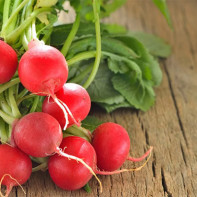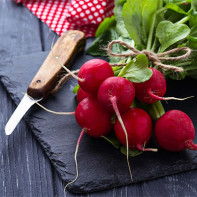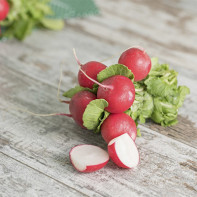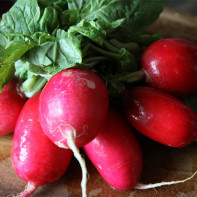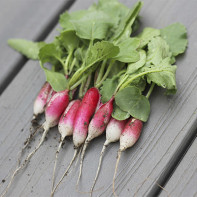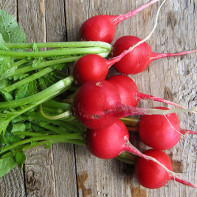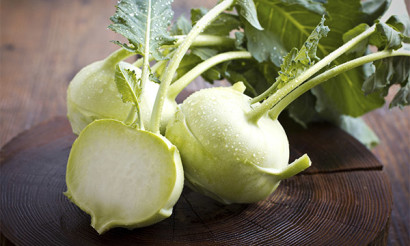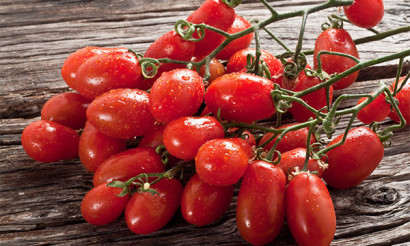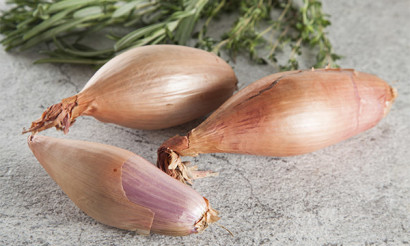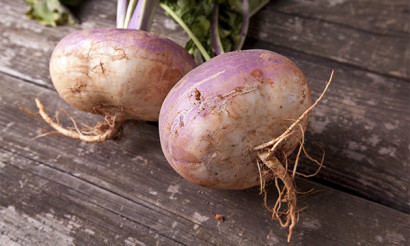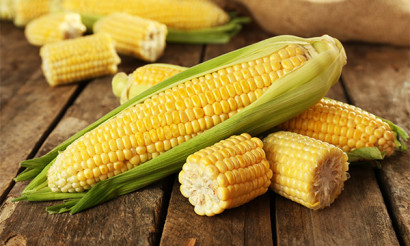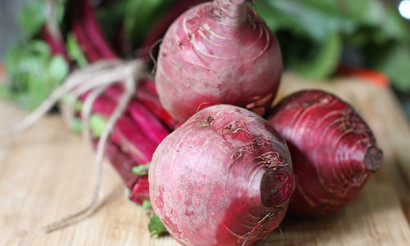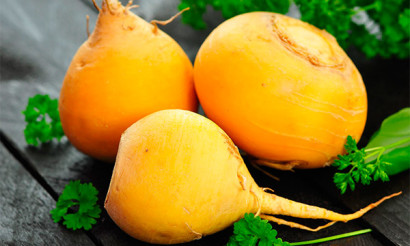Radish: calories, useful properties and contraindications.
Radishes belong to the cabbage family. The plant got its name from the Latin "radix", which translates as "root". The diameter of its root crops is more than 2.5 centimeters. The outer skin is quite thin and has a red, pink or white-pink color. Due to the considerable amount of mustard oil in the composition of the radish, its taste is characteristically sharp.
- What is the difference between radish and radish
- Composition and calories
- How useful are radishes
- General Benefits
- For Women
- For Men
- In Pregnancy
- For breastfeeding
- For Children
- Useful properties of radish leaves
- Can I Eat Radish as a Slimming Solution?
- Radish in medicine
- Diabetes mellitus
- For pancreatitis
- For gastritis
- For constipation
- For gout
- For the liver
- For hemorrhoids
- Radish-based folk medicine recipes
- From migraine and sciatica
- Intestinal atony and constipation
- Intestinal atony, avitaminosis, gastritis
- Avitaminosis and gallstones
- For constipation and bowel atony.
- Radish in cosmetology
- Lotion
- Radish Cosmetic Ice
- Refreshing Mask
- Harm and Contraindications
- How to Choose and Store Radish
- Can I freeze them?
- What can be made of radish
- Rules of Usage
- How much can I eat per day?
- Can I Eat at Night
- Can I Eat Radish Stems
- How to remove the bitterness from radishes
- Can we give radishes to animals?
- Dogs
- Guinea pigs
- Hamsters
- Rabbits
- Ducks
- Parrots
- Interesting facts about radishes
What is the difference between a radish and a radish
It is possible to distinguish the following essential features:
- Size. The diameter of radish root crops is usually no more than 3 cm, while radishes have a fundamentally larger diameter.
- Taste. Radishes have a slightly more delicate and spicy taste, although spiciness and bitterness are inherent in both vegetables.
- Color. The hue of radish is usually white or green, while radish has a wider variety of colors, being red, gray, purple, brown, rarely yellow.
- Sowing Period. For radishes, it is spring-summer. Radish are usually planted in mid-June to harvest in the fall.
As for the time of ripening, the timing of radish is much shorter. Already after 10-12 days the root crop develops a flowering stem. And after about 1 month you can collect a full-fledged harvest.
Composition and calories
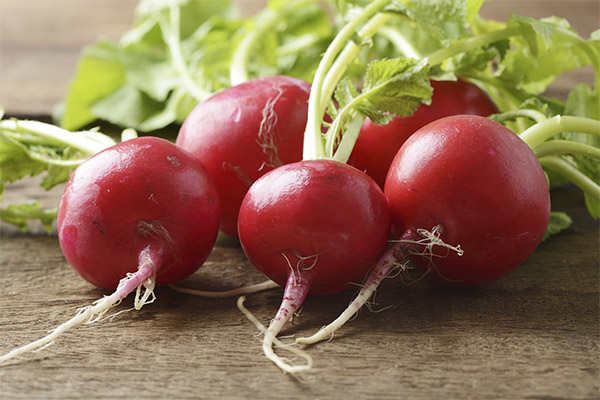
Radish contains a large number of chemical elements. These are vitamins A, B1, B2, B6, C, PP. The plant also contains:
- sugar;
- fiber;
- enzymes;
- fats;
- potassium;
- sodium;
- fluorine;
- phosphorus;
- chromium;
- zinc;
- sulfur;
- protein;
- other elements.
It is noteworthy that 100-120 g of this plant contains the daily allowance for humans in vitamin C.
As for calories, in 100 grams of fresh vegetables, this figure is only 14 kcal. Because of this, they can be consumed without health consequences for people with overweight, diabetes, liver and gallbladder problems.
What are radishes good for?
General benefits
Radish has beneficial effects on human health. It affects the entire body as a whole, has a tonic effect, gives vivacity for a long time. You can also highlight the following useful properties of the plant:
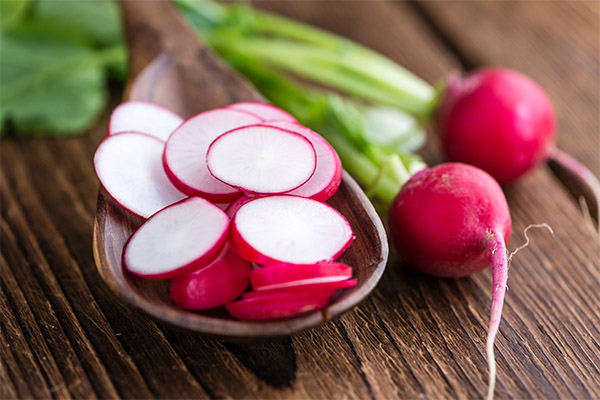
- Radishes contain antioxidants. They are often found in medicines designed to fight cancerous tumors. Experts report that taking these substances helps to block blood flow to cancer cells, causing them to break down. If you regularly consume this plant, the risk of getting sick is reduced by 65 percent.
- One of the main features of radish is a favorable effect on human immunity due to the high content of vitamin C. The use of a small amount of vegetables can provide the body with the necessary calcium, important acids and many other elements. Doctors recommend using radishes instead of vitamins from the pharmacy.
- B vitamins are beneficial to the nervous system. Periodic intake of this vegetable helps to feel calmer, improves sleep and eliminates excessive fatigue.
- Radish contains phytoncides, natural antibiotics. They fight bacteria in the mouth, eliminating bad odor. For an even greater effect, it is recommended to eat radishes together with other vegetables.
- The plant is used for preventive purposes during the flu season. It can strengthen the immune system, make it more resistant to viruses. And during the disease, the therapeutic effect has the juice of the root crop (1 tbsp. 3 times a day).
- The presence of fiber (2.5 times more than in the apple) improves the digestive system, increases metabolism, provides cells with necessary oxygen, increases blood circulation, thereby breaking down fats, which helps to lose extra pounds.
- The property of blood thinning promotes the prevention of diseases such as atherosclerosis, stroke, myocardial infarction and other cardiovascular diseases. Radish helps with varicose veins and any other thrombosis.
- Radish helps to control blood glucose levels, reducing the number of glucose spikes, which is necessary for people with type 2 diabetes. It is good for gout and obesity.
- Mustard oil, which gives the vegetable a bitter taste, acts as a natural antiseptic. It disinfects the cavity of internal organs and prevents inflammation.
- Radish root juice cleanses and disinfects wounds and abrasions, improving the regeneration of the skin. It also helps with headaches, just rub the juice on the temples. Using radish with grated prunes can reduce cravings for alcoholic beverages and easily overcome a hangover.
- Radish is widely used for cosmetic purposes. It helps to whiten the skin, even out skin texture, clear pores. To achieve this effect, you need to mix the radish, after grating it with lemon juice and use as a mask for 20 minutes.
As you can see, the list of useful properties of this vegetable is quite impressive.
For women
Radish has a positive effect on the female body.
- Periodic consumption of the vegetable significantly reduces the likelihood of cancer cells in the mammary glands.
- Also the digestive processes and the condition of the skin are improved.
- Radish regulates the water and salt balance, and removes excess fluid. The plant has a rejuvenating effect.
- The presence of a large amount of dietary fiber helps in the fight against excess weight.
For Men
- Radish salads have a positive effect on the cardiovascular system of the male body, which significantly reduces the risk of heart disease.
- Periodic consumption of the plant helps to remove unnecessary cholesterol. The vegetable improves the work of the whole body, has a beneficial effect on the functioning of the gastrointestinal tract.
- Radish is excellent in counteracting obesity, gout and diabetes. It satiates the body with energy, fights chronic fatigue, keeps potency in a normal state for many years.
During Pregnancy
During pregnancy, radish is a very useful product, mainly because of its high fiber content, which improves intestinal function. A similar ailment is faced by the majority of pregnant women. Such a problem as constipation is not uncommon, and laxatives can harm the baby.
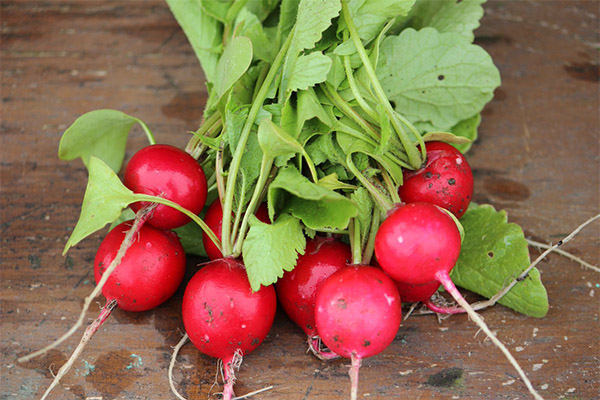
A considerable number of different vitamins makes radish for pregnant women simply a necessary component of the diet. However, there are also negative aspects. To radish had only had a beneficial effect, it is recommended to eat it only in stewed or cured warm form. Only in this case, you can not be afraid of adverse reactions.
Raw radishes can cause gas. It also contains a large number of pathogenic bacteria, so it is necessary to wash the root vegetable thoroughly before use. The use of baby soap is recommended.
When breastfeeding
When breastfeeding, you need to be very careful about the daily diet, because the condition of the gastrointestinal tract of the child depends on it. Due to the fact that the use of radishes causes colic, bloating and stool disorders in the baby, experts advise against eating radishes during breastfeeding. After the child reaches the age of 3 months, you can eat radishes in small quantities, after consulting with your doctor.
For kids
For children, radishes are a very useful product due to the abundance of vitamins and trace elements. But the taste of the vegetable, most likely, the child will not like, so it is recommended to give it in small quantities in salads. A child can consume radish from the age of two years, the minimum age is one and a half years, but only after consulting your doctor. It is important to make sure that the child has no gastrointestinal problems and food allergies.
At three years of age children are already recommended to give up to 40 grams of radish. Observing their health, you can eventually increase the amount of intake of vegetable.
Since radish improves appetite, you can use it as a snack if the child is not eating well. The vegetable also strengthens the hair, nails and teeth of children.
Useful properties of radish tops
The haulm of radish is most often thrown away, but it has all the same nutrients as the root vegetable, only in a smaller ratio. It has a pleasant taste with a slight bitterness. There is not much mustard oil in the haulm, which is why it is less spicy.
The presence of ascorbic acid (vitamin C) strengthens the walls of blood vessels and is good for immunity, folic acid (vitamin B9) has a beneficial effect on brain and nervous system activity, vitamin PP removes excess cholesterol, B1 and B2 help control blood sugar, calcium is necessary for bones, potassium is good for heart, iron reduces the risk of anemia.
On this basis, you should not throw away the radish tops. It is used in cooking in different salads in combination with other greens. Moreover, there are no particular restrictions on its use.
Can I eat radish when losing weight?
The abundance of mineral salts in the radish root helps to strengthen the immune system, which is very important for weight loss. The use of this vegetable has a beneficial effect on the human circulatory system, helps in the regeneration of tissues, especially bone, which means that the change in weight will not affect the body in a negative way.
Often, problems with extra pounds are associated with disorders of the gastrointestinal tract, and, as mentioned above, the regular use of radishes is able to adjust the activity of the digestive system. This is promoted by B vitamins. They also improve the cardiovascular system. Fiber helps to fight excess cholesterol.
When losing weight, not only the root vegetable is useful, but also the tops. It is recommended to regularly add it to salads, soups and other dishes to taste - it goes well with them.
Earlier it was written that radish can cause appetite, which is not a good thing during weight loss. Ascorbic acid (which is what affects appetite) is found in large quantities in the bright varieties, while there is virtually none in white varieties.
Radish in medicine
The useful properties of radish affect its wide use for medical purposes. It is used for a variety of ailments. Some of them will be discussed below.
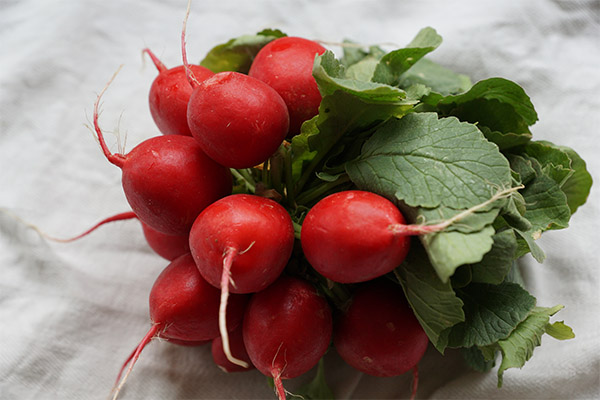
With diabetes mellitus
In diabetes, the consumption of radishes is very important. It not only contains important fiber, but also provides the human body with almost all the vitamins and minerals it needs. With the regular use of this vegetable can completely abandon the addition of salt in salads. In addition, some types of radishes are able to satisfy the hunger and completely satiate a person, without causing any harm to the figure.
The caloric value of radishes (14 kcal per 100 grams) allows you to eat them with type 2 diabetes. Fiber helps break down carbohydrates, fights sudden drops in glucose in the body.
Important: The glycemic index of radishes is 15 units.
In pancreatitis
Radish belongs to the list of products that are strictly forbidden to all people who suffer from acute pancreatitis or exacerbation of chronic disease. This is due to the following features:
- The vegetable promotes abundant secretion of pancreatic juice, which activates aggressive proteolytic enzymes (enzymes that break down proteins, as well as the gland itself).
- The plant has a choleretic effect on the body, which also affects the formation of the above enzymes.
- The root vegetable has a laxative effect.
Radish should not be consumed even in the case of remission.
With gastritis
Inflammation of the mucous membrane of the stomach is quite a serious problem, in which it is very important to eat right and monitor your diet. Since radish promotes excessive secretion of gastric juice, increasing its acidity, it is strictly forbidden to take it in food.
You can not eat this vegetable with a stomach ulcer and duodenal ulcer.
For constipation
Against constipation, a decoction made from the leafy stalks has proven excellent. It is necessary to pour a tablespoon of crushed plant with a glass of boiling water. Insist 1 hour. Drink for 2-3 days for a third of an hour before a meal.
With gout
With improper metabolism, uric acid salts collect in the joints, leading to the disease known as gout. The diet for this disease is important to choose carefully and carefully. The composition of radish has very little uric acid (9.6 mg per 100 grams), but still you should not use it for the duration of the disease.
The prohibition does not apply to the juice of the vegetable, which together with the carrot has a healing effect.
For the liver
With liver problems, a decoction of radish tops is recommended for use. It is prepared as follows: take a lot of greens, pour 2 cups of water, bring to a boil, leave until half of all water evaporates, add a little sugar and drink.
Take it for 3 days (so it is advisable to prepare in advance as much radish to have enough for the whole period), while minimizing the intake of other food and drinks, consuming only the decoction.
With hemorrhoids
With this disease, experts advise to increase the intake of products that contain coarse fiber (not digestible carbohydrates). They improve the digestive system and fight constipation, which is the main cause of hemorrhoids. The radish contains coarse fiber, so it is useful for this disease.
Traditional medicine recipes based on radishes
From radishes prepare decoctions that will help in the treatment of a variety of ailments.
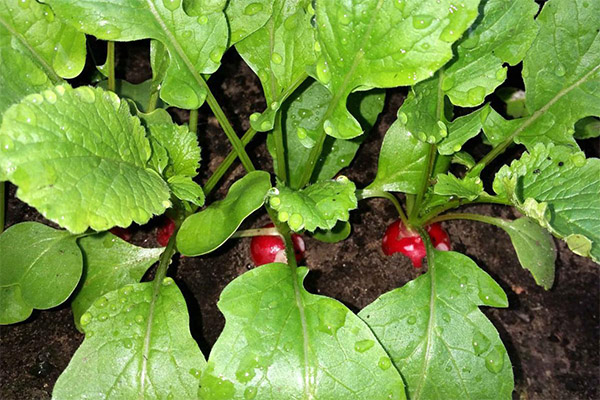
From migraine and sciatica
To prepare it, you will need the following ingredients:
- Radish tops - 10 g.
- Radish pulp - 10 g.
- Water - 0,2 l.
Preparation is carried out as follows:
- Mix the dried haulm with boiling water.
- Combine with the pulp, pre-shredded on a grater.
- Stir and allow to stand for half an hour at room temperature.
- Pass through gauze.
- Means apply to lotions twice a day.
With intestinal atony and constipation
Need:
- Radish tops - 20 g.
- Water - 0,2 l.
The algorithm of action looks like this:
- Wash the fresh tops.
- Dry with a towel.
- Cut it into small pieces.
- Add boiling water and let stand for 60 minutes.
- Run through gauze.
- Drink decoction for 3 days 50 ml after a meal 3 times a day.
With atony of the intestine, avitaminosis, gastritis
Decoction from the tops of radishes and carrots helps with intestinal atony, avitaminosis, gastritis with low acidity of the gastric juice.
Ingredients:
- Radish tots - 15 g.
- The tops of carrots - 5 g.
- Water - 0,2 m.
Cooking method:
- The dried leaves of both vegetables need to be thoroughly crushed.
- Add boiling water.
- Leave for a quarter of an hour.
- Pass through gauze.
- Take 50 ml several times a day.
Avitaminosis and gallstones
Needed:
- Radish tops - 10 g.
- Chaber leaves - 10 gr.
- Salt - 2 g.
- Water - 0.3 l.
Prepare the broth as follows:
- Grind radish tops and chaber. Mix together.
- Add salt to the water. Pour the mixture into the water.
- Put it in the fridge for a few days.
- Pass through gauze.
- Drink decoction warm several times a day for 30-40 ml.
From constipation and bowel atony.
You will need the following components:
- Radish leaves - 10 g.
- The tops of beets - 5 g.
- Water - 0,2 liters.
Method of preparation:
- Dry and grind the tops of beets and radishes. Mix them.
- Add boiling water.
- Cover and leave to soak for a quarter of an hour.
- Pass through gauze.
- Take 50 ml 3-4 times a day.
There are quite a large number of solutions, and each of them is useful for one or another disease.
Radish in cosmetology
Radish is widely used for cosmetic purposes. It has the following useful properties:
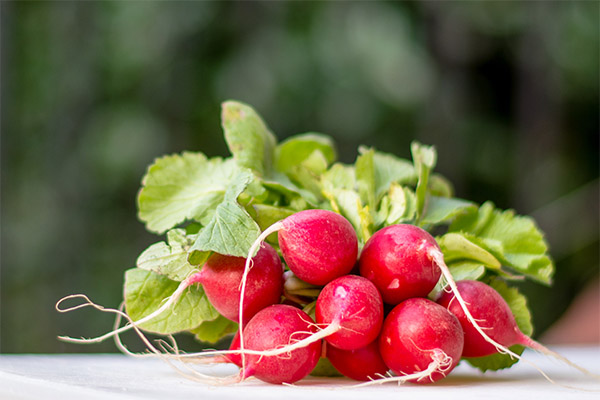
- nourishes and moisturizes;
- refreshes and tones;
- Restores skin tone;
- Fights dryness and irritation.
Radish-based products can be used by people with both normal and prone to dry skin. There are several common recipes for cosmetic products, the main components of which is radish.
Lotion
Radish lotion tones and moisturizes the skin, improves its regenerative properties. The product rejuvenates the skin, gives it a firm, fresh appearance.
The lotion requires the following ingredients:
- Radish juice - 15 ml.
- Almond oil - 5 ml.
- Mineral water - 0,1 l.
To prepare it is enough to mix all the components together. It is convenient to use a special container with the ability to adjust the doses. Apply twice a day, wiping the skin with a sponge.
Radish cosmetic ice
Radish ice enhances the production of elastin, which smoothes the skin and rejuvenates it. This remedy is in no way inferior to salon cosmetic preparations, it provides the skin with useful microelements.
To prepare it, you will need:
- Radish - 20 g.
- Olive oil - 10 ml.
- Tocopherol - 20 drops.
Preparation process:
- Process the radish with a blender until it is mushy.
- Mix the oil and tocopherol and add the mixture to the radish puree.
- Spread the mixture into moulds and leave to freeze.
- Before going to bed after removing your makeup, wipe your face with the ice.
- Repeat for 12 days.
Mask is contraindicated in cases of couperose.
Refreshing mask
Refreshing mask on the basis of radishes gives skin elasticity and freshness. It helps to remove dead cells and oxygenates the skin.
Ingredients:
- Radish.
- Parsley.
- Rye flour - 1 tsp.
Preparation:
- Process the plant with a grater.
- Mix with parsley juice and flour.
Before the direct application of the mask it is necessary to rub the face with a hot compress for 3-4 minutes to open pores as much as possible. This will help the useful components of the mask to penetrate deeper into the skin layers. Only after that you can apply the composition. Hold for a third of an hour.
Harms and contraindications
Acceptance of radishes as food is contraindicated in the presence of a person's allergy to plants from the cabbage family. Also, you should refuse to eat the vegetable to people with gallstones, because the specific composition promotes the intensification of bile formation.
You should not eat too many radishes, as it has a bad effect on the activity of the gastrointestinal tract. It also interferes with the synthesis of thyroid hormones.
How to choose and store radishes
Make the right choice of the vegetable will help its appearance. Before buying, it is necessary to carefully inspect the fruit for darkening and damage. The root vegetable should be smooth and have a uniform color.
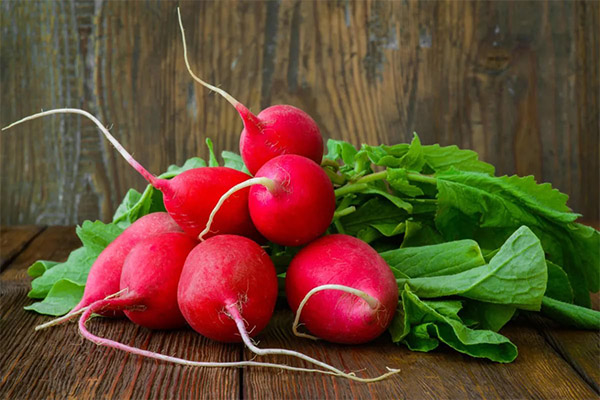
Before storing the tops should be separated from the roots. Leaves are recommended to use immediately, as they can not keep fresh for a long time. Roots, on the other hand, can be stored for a while. The storage duration depends directly on the variety and varies from 1 week to several months.
Either a refrigerator or a cellar can be used as storage. In the first case, the plant can retain its freshness for 4 weeks. The period depends on the storage method. In the cellar, vegetables can last all winter, if you follow some conditions and choose the right variety.
Can I freeze them
You can freeze radishes, but it is not recommended to do so. It is best to consume the vegetables within a short time after harvesting. But if there is a lot of it, then you have to resort to freezing. This can be done only if the strict requirements for processing the plant before harvesting and its further storage are observed.
What can be cooked with radishes
The culinary use of radishes is extremely extensive. They are often added to salads and used as an ingredient in sandwiches for a quick snack. The plant is often used in cooking soups and various other dishes.
Rules of Usage
How much can I eat per day?
Radish is a useful vegetable, but because of its specific taste, not many people like it, so not everyone can eat it in large quantities. Yes, and it is not recommended to do this, especially in diseases related to the gastrointestinal tract.
Experts advise to eat no more than 4-5 pieces of medium-sized radishes, and with a strong stomach, you can eat 10-12 pieces, but no more. It is also important to eat the vegetable separately from other products, and most importantly - not on an empty stomach.
The best way to eat radishes at night
The use of radishes at night is allowed only in small quantities - 1-2 pieces, preferably a few hours before bedtime. During the weight loss it all depends on the diet, but also it is not necessary to eat this vegetable before going to bed, although from one fruit there will be no significant harm.
Since radishes saturate the body with energy, eating them at night can have an adverse effect on sleep.
Can I eat radish tops?
You can and should eat radish leaves. It contains the same vitamins and minerals as in the root vegetable. However, it has a milder taste and perfectly complements a variety of salads.
It is important to remember that radish haulm in fresh form can be stored for a short time, so it is recommended to use it immediately.
How to remove bitterness from radishes
Bitterness from the vegetable can be removed in one of the following ways:
- Soak in salted water.
- Wash the cut parts of the root vegetable with water and salt.
- Process with boiling water.
- Slice and pour lemon juice, then add some sugar to it.
- Salt, rinse and sprinkle with lemon juice.
Use these simple methods to remove the bitterness of radishes.
Can I Give Radishes to Animals
Dogs
It is very important to feed dogs not only canned food and meat, but also fresh vegetables and root vegetables. Among the latter are radishes. Only it should be given in small quantities.
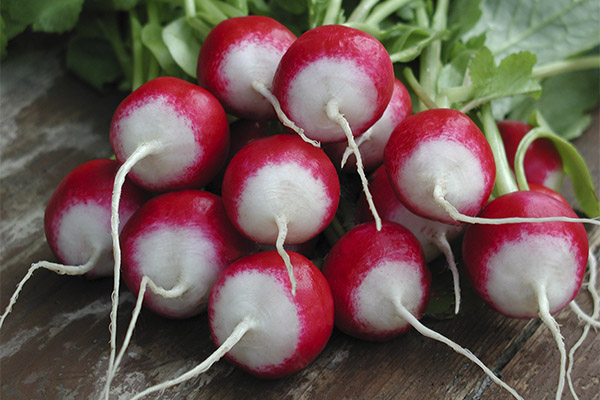
Guinea pigs
It is recommended to give guinea pigs small doses of radish tops. These animals are good at absorbing vitamin C, which is exactly what these vegetables contain.
Hamsters
Radish for hamsters is a very useful food. And they are given both the tops and root vegetables, but it is important not to abuse this vegetable.
Rabbits
Give radishes for rabbits as early as 1 month after birth - at first in small doses (no more than 2 root vegetables), then gradually increasing the volume.
Rabbits useful to eat and haulm, but only in fresh form.
Ducklings
Ducks can be given only fresh pure radish haulm in small amounts. As for root vegetables, only very small amounts should be given to snails because of their strong bitterness.
Parrots
For parrots, eating greens is a must. It saturates them with necessary vitamins and microelements, so radish leaves are an excellent food for them. Root vegetables are strictly forbidden for these birds.
Interesting facts about radishes
- Relatives of radishes are not only turnips and radishes, but also cabbage and mustard.
- Radish is a native of India, and was brought to Europe by the traveler Marco Polo.
- In Europe, this plant is often called the "French radish" because of the great love of the inhabitants of France for this vegetable.
- In Russia, radish, like potatoes, was brought by Peter I in the 18th century.
- One Israeli farmer managed to grow a radish weighing 10 kilos. For comparison, on average, one radish weighs only about 20-30 g.
«Important: All information on this site is provided for informational purposes only. For information purposes only. Before applying any recommendations, consult a health care professional. specialist. Neither the editors nor the authors shall be liable for any possible harm caused by materials."

